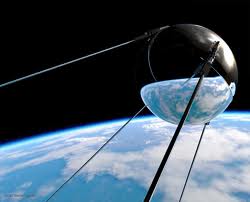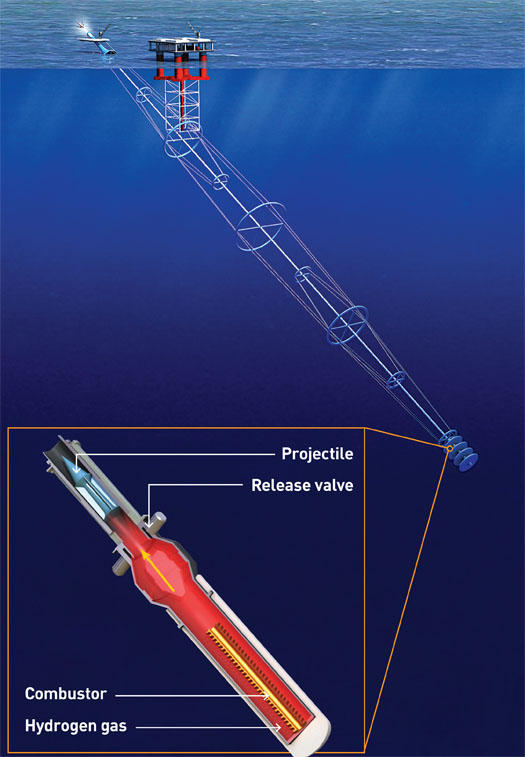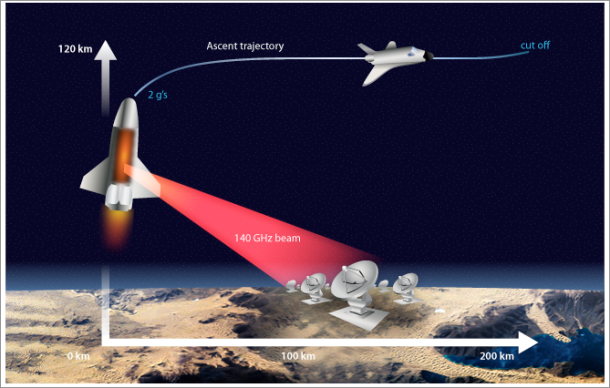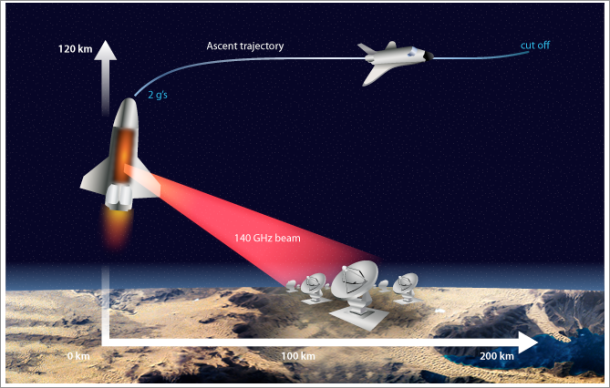Fifty-five years ago on October 4th, the Soviet Union launched Sputnik. Twelve years later two astronauts landed on the Moon and returned to Earth. Today humans occupy the International Space Station for long periods of time studying the effects of space on our physiology while robots explore the surface of Mars and spacecraft orbit planets from Mercury to Saturn. Two spacecraft we launched in the 1970s have reached the outer limits of our Solar System and are entering interstellar space. And a satellite launched a few years ago is discovering remote planets circling nearby stars.

Fifty-five years with so many advances in our knowledge, but very little in the way of advancement in the way we send humans and payloads into space. Because we continue to rely on chemical-based propulsion systems to climb out of the gravity well that is Earth. What if there were another way to get off the planet? What, if instead of putting the propulsion system at the tail end of the payload we want to launch we remove it entirely?
In past blog entries we have talked about the future of rocketry with heavy launch systems, nuclear rockets, solar sails, plasma engines, and other propulsion technologies. Heavy launch whether Ariane, NASA’s Space Launch System, Space X Falcon Heavy, or Russia’s Angara are all chemical-based. The others are technologies that cannot get us off the ground into space but are choices we can make once out of the Earth’s atmosphere.
Currently we have seen the development of hybrid launch technologies for sub-orbital flights. Virgin Galactic is a good example with its White Knight and SpaceShipOne mated configuration. But engineers and scientists have proposed other alternatives as well. These include:
- Space Elevators – We have mentioned space elevators in previous blogs. First proposed in 1960 by a Soviet scientist, Yuri Artsutanov, the idea has recently been revived with the discovery of carbon nanotubes, a material strong enough to tether a ground-based station to a space platform in low-Earth orbit. A space elevator could move payloads into Earth orbit at one hundredth the cost of current chemical launch systems.
- Catapult Launch – Historically catapults were used as siege engines to hurl large projectiles over city walls. The issue is size. To launch a large payload into space would require a significantly larger catapult with a counterweight arm. To launch an unpowered one kiloton payload into orbit at escape velocity would require a massive catapult arm stretching as much as 80 meters in length counterbalanced by a 100 kiloton weight. Doesn’t sound like this has much potential.
- Space Cannon – As proposed by John Hunter, the device, a gas propelled gun, would be a one kilometer (3,600 foot) in length and could send payloads into space for as little as $550 per kilogram ($250 per pound). The gun would use a mechanism to compress hydrogen gas which upon release would propel a projectile at a velocity to escape the atmosphere.

- Maglev Launch – also mentioned in a previous blog posting, uses the technology in maglev trains, superconducting magnets, to accelerate a payload in a vacuum-sealed ascending tunnel to achieve escape velocity speeds.
- Laser and Microwave Propulsion – also known as beamed thermal propulsion would involve pushing an object into space by shining a laser or microwave beam on to a heat exchange system which would then heat on board liquid hydrogen converting it to a gas and pushing it through a rocket nozzle. Such a beamed device would take 8 to 10 minutes to achieve orbit if using a laser, and 3 to 4 minutes if using microwaves as a source. This would be an effective way to launch small payloads into orbit and would be much safer than chemical rockets.

Today we launch satellites from locations at relatively low elevations. The Baikonur Cosmodrome sits 90 meters above sea level. Cape Canaveral sits on the edge of the Atlantic Ocean. The Guiana Space Center is another coastal site from which the European Space Agency launches its satellites. Jiuquan, where China launches its human space flight program sits 1,000 meters (3,300 feet) above sea level. Spaceport America, Virgin Galactic’s new commercial launch site sits 1,400 meters (4.595 feet) above sea level. To minimize the gravity well I wonder why we are not launching rockets from locations at much higher elevations. One could argue the top of mountains would be most suitable. And a mountain top near the Equator would prove to be ideal. Some engineers have suggested that launching from a mountain top would not only dramatically cut down on chemical rocket fuel requirements it would also limit the amount of stress the rocket would experience as it ascends. Current rockets throttle back during ascent to avoid structural damage from air resistance. This is referred to as Max Q or maximum dynamic pressure. In thinner air this would go away. It was during throttle up after passing through Max Q that the Space Shuttle Challenger in 1986 exploded.

As we experience the next 55 years in space it is clear that we will need to change the technology we currently use to make space more accessible from Earth and far more affordable. Advanced chemical-based launch systems may continue to get large payloads into near-Earth space but as the century unfolds where we go will depend on us changing this paradigm. Only then will space become an experience not for just a select few.
















None of the five boost-to-orbit schemes you mention seems technically promising, and all are hugely expensive. The giant trebuchet and space elevator schemes are practically impossible. Each of the schemes depends on directly or indirectly accelerating a “reaction mass” in the classical physics “equal and opposite direction” from the desired payload trajectory. That brings you immediately to the Specific Impulse factor: How much force for how long for each unit of reaction mass expended. Only when something with mass “pushes” against the backside of your payload can it accelerate. With present metallurgical thermal constraints, pure chemical rockets are limited to about 500-lb/sec/lb specific impulse. That’s only about 25% of SI that would be needed to orbit a pound of payload at a cost of $100.
But all is not impossible. Very high specific impulse is available within the atmosphere using existing reaction propulsion technology. See propulsion performance chart at: http://en.wikipedia.org/wiki/Specific_impulse
Notice the relatively prosaic Boeing 747 engines, GE CF6, achieve an effective specific impulse of approximately 6,000 lb/sec/lb. That’s because the CF6 power plant burns fuel to heat air mass that “pushes” against the back side of turbo compressor blades and the turbo fan. The engine harnesses the chemical energy in the fuel to sort of screw the engine’s turbines through the mass of the atmospheric medium through which it travels. Obviously a 747 airliner traveling at say 4,000 mph at 80,000 would promptly melt and disintegrate. But the SR-71 spy plane proved many times that turbojet/turboram type engines can achieve speeds of 2300 mph at altitudes over 80,000 feet. The SR-71 wasn’t designed to “fly” into orbit, but there is nothing in principle that would prohibit very high specific impulse turboram engines propelling a quasi-space plane to say 4,000 mph at an altitude of 140,000 feet, which would put it above 98% of the atmosphere, and eliminate 98% of the drag and thermal stress.
Notice the linked propulsion performance chart shows the 1962 era Pratt J-58 turbo ram engines in the SR-71 achieved an effective specific impulse of approximately 2000 (4-times pure rocket). That sort of concept in a scaled up and more refined hypersonic booster plane could in principle deliver pure rocket payloads traveling at 4,000-mph to 140,000-feet. Then pure rockets with SI in the 500 lb/sec/lb could take over and provide the additional very low atmospheric drag acceleration needed to reach orbit. The booster plane would then just fly back to the launch runway to refuel and take on another pure rocket payload.
If the space booster plane uses hydrogen as fuel, it’s possible in principle to reach Mach-7 speeds and specific impulse in the 7,000-range. Development costs for such a system would likely run several hundred billion US dollars. But if you intend to put millions of tons into orbit, it would not only work, but it would work at lower costs than any other approach. Mind you, I am not advocating that mankind undertake development of a quasi-space plane and orbital booster project; I’m just saying it’s less bad than any other scheme to put man in space I know of, and should approach the $100/pound costs.
Frankly, I’m against manned space flight unless, and until, Earth based AI robot workers can build and operate the launch systems. Hominid health deteriorates rapidly in low gravity environments, so artificial gravity is essential. The laws of physics dictate the size of a permanent hominid space habitat be at least 600-feet in diameter, with 1200-foot diameter being preferable. If human “crews” are going to visit other planets, they will likely be traveling in 600-foot, or larger, diameter wheel ships. Then there is the lethal radiation issue. Only massive shielding can solve that problem. Bottom line is only very large and massive habitats and ships are workable. Develop those smart robots first, then worry about putting men in space.
There is of course the imponderable prospect of non-reactive thrust, where in principle our space propulsion engines could react with mass in other dimensions or with dark matter. That would need some physics we don’t yet have, and have no way to know if we ever will.
When Columbus set off on his voyage across the Atlantic Ocean he was as ill prepared in many ways as our spacefarers. He had a few more things going in his favour. He could still find food from the sea and he didn’t have to carry his oxygen supply with him. And yet many of his crew perished because of a lack of basic understanding of proper nutrition.
There is no doubt that human spaceflight for any Deep Space mission needs a technological reboot by those in the business of designing and populating space habitats. We need artificial gravity and that means big ships. We need the materials to construct them in space. We need to build effective shielding against cosmic rays. And we need to perfect closed habitable systems that are self-sustaining to ensure long-term human survival.
It would be far easier to send robots and use AI and telepresence technologies to let us touch down on remote locations in the Solar System. But I sense that in the end those who thirst to discover will go into space on missions like Columbus on his voyages to America without all of the technology in place to ensure human safety despite our implicit understanding of what is needed. That may be folly but that certainly is human.
Len says: “When Columbus set off on his voyage across the Atlantic Ocean he was as ill prepared in many ways as our spacefarers. He had a few more things going in his favour. He could still find food from the sea and he didn’t have to carry his oxygen supply with him. And yet many of his crew perished because of a lack of basic understanding of proper nutrition.”
I take your valid point, but the relative costs of Columbus’ voyages were a trivial percentage of Spain’s “economy” and royal treasures, plus the reasonable expectation was that a demonstration of a shorter route to the riches of Asia would promptly repay the investment and justify the risks. As events developed, the short route to Asia proposition failed (Columbus probably had a fair understanding of the true scale of the globe, as did the ancient Egyptians, Greeks and Romans. Columbus likely expected to reach the “New World,” not Asia. Seems likely technical advisors to the Spanish Court informed the Crown that there was absolutely no way that Columbus could reach Asia by sea because the distances were too vast.), but within a couple of decades Spanish exploitation of the “New World’s” gold and silver had repaid the crown’s initial investments a thousand fold. (Interestingly the flood of cheaply produced gold and silver coming back to Spain soon devalued all the gold and silver in Europe. That forced all the other European nations to either join the New World gold rush, or else fade into economic and military obscurity. Had Columbus actually proven a short route to Asia, in contrast to the New World flood of gold and silver, the economic benefits to Spain would have been relatively small.)
Man in space is nothing like that. If there is to ever be any repayment of the huge costs to go, it would only be after several generations. The costs represent a substantial percentage of any Earth nation’s GDP for many years. I’m saying just the ante alone to rationally enter the man in space game with an economical orbital boost system is likely in excess of $200-billion. That is just the come-on ante; not any sort of major bet. Space has infinite capacity to absorb Earth’s resources. Trying to move mankind into space prematurely is not only economically foolish, it’s ethically unjust.
Those who must pay the costs have a fair right to ask, “What will I and my family receive for paying the costs?” Looks like the honest answer is, “Almost nothing, and the injustice to you is compounded by the fact that if the costs were invested in Earth-bound technology and infrastructure, you and your children would live significantly better lives.”
Ethical justice to those who must pay to put mankind into space can only come from previous development on Earth of AI and robotics, and perhaps new and better sources of energy and propulsion. Humanity can wait a few decades, improve its conditions on Earth, and then go into space the smart ethical way.
Good analysis of the Columbus voyages of discovery. You are right in pointing out the enormous cost of any venture into space. And maybe we can sort out the mess here on Earth before we venture among the planets that are our neighbours. But there will still be a few dreamers who will push the space agenda and will take undue risks just to get over that far horizon to say they did it. That’s humanity and our nature.